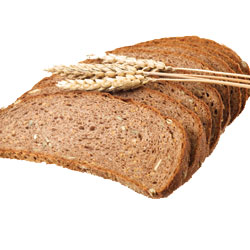Becoming Supermarket Savvy
You know by now that one of the easiest ways to avoid temptation is to avoid bringing high-fat, high-sugar foods into your home in the first place. This effort begins in the supermarket, so learning to shop more effectively can be one of the most useful skills when trying to create new, healthy lifestyle habits. Studies have shown that moms make more than 90% of the food purchasing decisions, so now's the time to learn how to make those decisions smart ones!
The first step is to avoid the random impulse purchasing of binge-inducing trigger foods. The easiest way to do this is by shopping with a prepared list. Sitting down to write a list out may seem like a big task, but you can make it easier.
An easy trick is to keep a running list easily accessible in your kitchen - maybe hanging on the refrigerator. When you are running low on something, jot it down. When you think of a healthy meal you'd like to try, write down the ingredients. When you see a picture, advertisement or recipe for a delicious healthy meal, grab your list and write it down.
Another great shortcut in list making (and healthy meal planning) is to subscribe to a service like The Six O'Clock Scramble, which not only gives you a week of healthy recipes, but comes with a handy grocery list including everything you need to make all of the recipes!
Once you have your list, make sure you only take the list to the supermarket. Leave your hunger and your kids at home.
If you food shop when you're hungry, you're much more tempted to buy things you would normally be able to bypass. By having a light snack or mini meal before you enter the supermarket, you're judgment will stay intact and you will be able to make more sound choices.
Have you noticed how much more junk food you buy when you bring your kids to the supermarket with you?
"Mom, can you pleeeeeease buy this (sugary, calorie-laden) cereal I saw on TV?"
"Mom, everyone brings in these (high fat, high cholesterol, nutrient void) snacks to school!"
The battles can be endless in the supermarket, with foods containing the least nutrition and the most far, sugar and calories strategically placed right at your children's eye level. If you must bring your children, also bring a strong resolve to stick to your list. If you have a choice, leave the kids at home and take a few moments for yourself. You can use the opportunity to make better choices that the whole family will benefit from.
So, you're armed with your list, you've had a snack and now you are alone in the supermarket.
Where do you begin?
First, let's talk about labels.
1.) The first think to notice when looking at a nutrition label is to note the number of servings in the package. The calories, fat, cholesterol, fiber and sodium are all listed for only one serving. So, for example, if you buy a bag of popcorn and the bag contains ten servings and you finish the bag, the calories, fat, cholesterol and other nutritional information must all be multiplied by ten to understand what you have just consumed.
2.) Ingredients are listed in order from the highest concentration to the lowest. This means that if sugar or fat are listed within the first few ingredients, there's a high concentration of sugar or fat on the item. The reverse is also true. If the healthy-sounding ingredients - the fruit, the whole grains - are at the end of the ingredient list, there is likely to be only a tiny bit of them in the product.
3.) Sugar is often disguised under different names. High fructose corn syrup, any ingredient ending in "-ose", honey, molasses, fruit juice concentrate, and brown sugar are all forms of sugar that act just like regular, white, refined sugar within your body.
4.) If the front label claims that the food is "healthy", "low-fat", "wholesome", "made with whole grain", "made with fruit", check the back label to see what the real story is. Food producers do not generally have your good health in mind when they put foods on the shelf. They want the foods to sell, and they know that these kinds of claims catch the attention of people who are trying to eat healthier foods. But the ingredients often tell a different story. Foods may be low in sugar, but high in fat and artificial coloring. They may contain a small amount of whole grain, along with a hefty dose of white flour and high fructose corn syrup. Make sure you look at the whole label and don't rely on the health claims to guide your choices.
5.) How many of the ingredients on the list look familiar? How many can you pronounce? How many would you feel comfortable including in something you were cooking or baking at home? When you were a child and your grandmother baked her delicious, mouth-watering apple pie, the only flavor enhancer she added was the love that went into baking it for you. Although there are thousands of items available in the typical supermarket today, an alarming amount are pre-packaged, processed and provide little nutrient value.
When a food is processed, it is altered from its natural state. Valuable nutrients, vitamins and minerals are taken out while chemicals and additives are injected back in. Food dyes, flavor enhancers, stabilizers and preservatives may make food look more colorful or extend shelf life but think about it. If a product can last indefinitely in a store or a vending machine, what happens to it when it's in your body?
An easy rule to make healthy purchasing decisions would be this: if you can't pronounce it, if you wouldn't add it to anything you were cooking or baking at home, if you wouldn't find the ingredient listed anywhere in your favorite cookbook, it's probably best not to eat it.
So what are the healthiest choices to make when food shopping?
Most of the healthiest foods are located in the outermost aisles of the supermarket. These include the fruit, vegetable, dairy and meat departments.
Let's start in the produce department. Here's where you really want to fill up your cart. Pile in beautiful, interesting and colorful fruits and vegetables. Different colors of fruits and vegetables offer different nutrients, so just by making colorful selections, you're automatically increasing your chances of getting a wide variety of healthy nutrients. There are also many varieties of prewashed, precut lettuces and other vegetables available, making it easy to prepare interesting salads and side dishes. Here's where you splurge, because if a variety of pretty, precut vegetables are available at home, your may reconsider eating pre-packaged, processed junk food.
In the meat section opt for leaner cuts of beef, chicken and turkey. Choose cuts with less visible fat to decrease your intake of saturated fat. If you are buying ground meat, look closely at the percent of fat (most labels now show the fat content) and buy the leanest version. With fish, choose both fatty (salmon and tuna) and lean varieties. Fatty fish are great sources of omega 3's and white colored varieties (flounder, sole, and halibut) are low in fat and calories.
In the dairy section look for words such as "low fat", "non fat", "fat free", "1 percent", "2 percent", and "skim". Consider switching to skim milk, or at least working your way down to 2%, then 1% and then skim. Whole milk contains about 3.5% fat (and 150 calories in a serving), so 2% milk is still more than half of the fat (and 120 calories), while skim milk has only .4 grams of fat and 86 calories per serving.
Eggs, butter, margarine and soy products are often in these aisles so read labels and choose carefully. Watch the fat in your dairy products and look out for added sugar in yogurts, creamers and soy milk.
You can still pick up healthy items in some of the center aisles if you choose carefully. In the grain aisle, try to avoid refined carbohydrates and opt for whole grain and high fiber whenever possible. Choose 100% whole-wheat or sprouted grain bread, high-fiber cereals, whole-grain pasta, and brown rice. The closer the grain is to its natural source, the more fiber and nutrients it contains. Beans can also be found in either the grain or canned food aisles. Dry beans require soaking, which may not appeal to you. Canned beans are just as nutritious, so if you'll eat more beans this way, buy the canned version! In the frozen foods section, you might want to grab a few bags of frozen vegetables or mixed blends (without the added sauces or butter flavoring). Frozen vegetables retain the vitamins and nutrients while being convenient and easy to prepare.
When you work on becoming more supermarket savvy, you become more familiar with labels, packaging, and products available in your supermarket and you begin to realize that your shopping trips can either be the first step in preparing a healthy eating environment in your home, instead of a war zone where you battle with your best intentions, your cravings and your judgement.
-
Common Sense Approach To Weight Loss
The foods in a diet for fat loss help yo
-
Are The Health Benefits Of Acai Berry Good For You
The acai berry has been marketed as a wo
-
Can Treadmill Training Help You Lose Weight?
Its amazing how the modern media promotes diets programs, pills and
-
Exercise can improve your arthritis
Exercise can seem near impossible if you have arthritis pain. A
-
Is It True Losing Weight Be That Simple?
Losing weight is not that simple, and it takes dedication , weve got
-
Best Abs Exercise Routines Revealed
Getting a nice looking mid section is a common goal for people getting
- DON'T MISS
- 6 Rapid Weight Loss Tips
- Understanding Metabolism: How to Boost Yours with Exercise
- How To Avoid Stress
- Is LowCarb Really The Way To Go
- Getting Plenty Of Sleep Is Essential To Weight Loss
- Weight Loss Surgery: New Beginnings
- Pregnancy Weight Loss
- Be Careful of Fad Diets - Learn The Basic Principles of lasting Weight Loss
- Your Reasons to Lose Weight Will Increase Your Motivation
- Doctor Why Cant I Loose Weight And By The Way Why Do I Feel Sick




